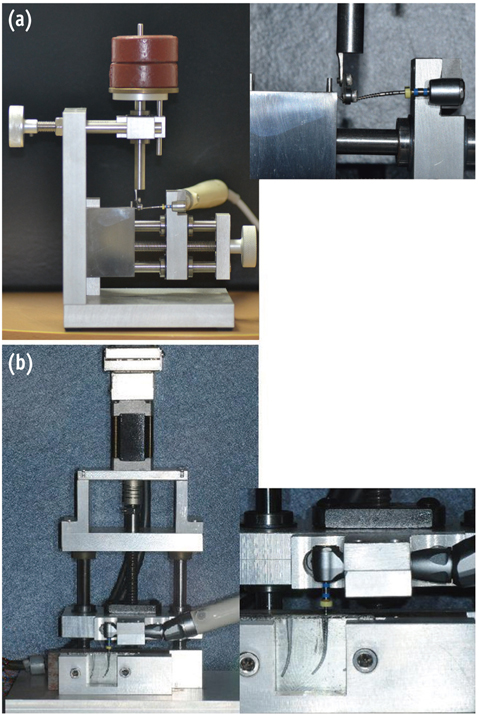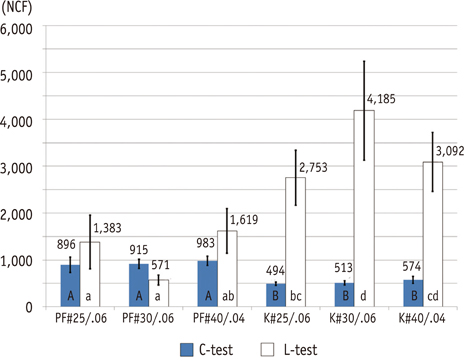Restor Dent Endod.
2013 Feb;38(1):31-35. 10.5395/rde.2013.38.1.31.
Cyclic fatigue resistance tests of Nickel-Titanium rotary files using simulated canal and weight loading conditions
- Affiliations
-
- 1Department of Conservative Dentistry, Pusan National University School of Dentistry, Yangsan, Korea. golddent@pusan.ac.kr
- 2Department of Bioscience Research, University of Tennessee Health Science Center College of Dentistry, Memphis, USA.
- 3Area of Endodontics, the University of Hong Kong Faculty of Dentistry, Hong Kong SAR, China.
- 4Department of Conservative Dentistry, Kyungpook National University School of Dentistry, Daegu, Korea.
- KMID: 1995474
- DOI: http://doi.org/10.5395/rde.2013.38.1.31
Abstract
OBJECTIVES
This study compared the cyclic fatigue resistance of nickel-titanium (NiTi) files obtained in a conventional test using a simulated canal with a newly developed method that allows the application of constant fatigue load conditions.
MATERIALS AND METHODS
ProFile and K3 files of #25/.06, #30/.06, and #40/.04 were selected. Two types of testing devices were built to test their fatigue performance. The first (conventional) device prescribed curvature inside a simulated canal (C-test), the second new device exerted a constant load (L-test) whilst allowing any resulting curvature. Ten new instruments of each size and brand were tested with each device. The files were rotated until fracture and the number of cycles to failure (NCF) was determined. The NCF were subjected to one-way ANOVA and Duncan's post-hoc test for each method. Spearman's rank correlation coefficient was computed to examine any association between methods.
RESULTS
Spearman's rank correlation coefficient (rho = -0.905) showed a significant negative correlation between methods. Groups with significant difference after the L-test divided into 4 clusters, whilst the C-test gave just 2 clusters. From the L-test, considering the negative correlation of NCF, K3 gave a significantly lower fatigue resistance than ProFile as in the C-test. K3 #30/.06 showed a lower fatigue resistance than K3 #25/.06, which was not found by the C-test. Variation in fatigue test methodology resulted in different cyclic fatigue resistance rankings for various NiTi files.
CONCLUSIONS
The new methodology standardized the load during fatigue testing, allowing determination fatigue behavior under constant load conditions.
Keyword
MeSH Terms
Figure
Cited by 2 articles
-
Buckling resistance, bending stiffness, and torsional resistance of various instruments for canal exploration and glide path preparation
Sang-Won Kwak, Jung-Hong Ha, WooCheol Lee, Sung-Kyo Kim, Hyeon-Cheol Kim
Restor Dent Endod. 2014;39(4):270-275. doi: 10.5395/rde.2014.39.4.270.Effect of surface treatment on the mechanical properties of nickel-titanium files with a similar cross-section
Sang Won Kwak, Joo Yeong Lee, Hye-Jin Goo, Hyeon-Cheol Kim
Restor Dent Endod. 2017;42(3):216-223. doi: 10.5395/rde.2017.42.3.216.
Reference
-
1. Glossen CR, Haller RH, Dove SB, del Rio CE. A comparison of root canal preparations using Ni-Ti hand, Ni-Ti engine-driven, and K-Flex endodontic instruments. J Endod. 1995. 21:146–151.
Article2. Sattapan B, Nervo GJ, Palamara JE, Messer HH. Defects in rotary nickel–titanium files after clinical use. J Endod. 2000. 26:161–165.
Article3. Cheung GSP. Instrument fracture: mechanisms, removal of fragments, and clinical outcomes. Endod Top. 2009. 16:1–26.
Article4. Pruett JP, Clement DJ, Carnes DL Jr. Cyclic fatigue testing of nickel-titanium endodontic instruments. J Endod. 1997. 23:77–85.
Article5. Kim HC, Kim HJ, Lee CJ, Kim BM, Park JK, Versluis A. Mechanical response of nickel-titanium instruments with different cross-sectional designs during shaping of simulated curved canals. Int Endod J. 2009. 42:593–602.
Article6. Kim TO, Cheung GS, Lee JM, Kim BM, Hur B, Kim HC. Stress distribution of three NiTi rotary files under bending and torsional conditions using a mathematic analysis. Int Endod J. 2009. 42:14–21.
Article7. Kim HC, Yum J, Hur B, Cheung GS. Cyclic fatigue and fracture characteristics of ground and twisted nickel-titanium rotary files. J Endod. 2010. 36:147–152.
Article8. Bahia MG, Buono VT. Decrease in the fatigue resistance of nickel-titanium rotary instruments after clinical use in curved root canals. Oral Surg Oral Med Oral Pathol Oral Radiol Endod. 2005. 100:249–255.
Article9. Haïkel Y, Serfaty R, Bateman G, Senger B, Allemann C. Dynamic and cyclic fatigue of engine-driven rotary nickel-titanium endodontic instruments. J Endod. 1999. 25:434–440.
Article10. Gambarini G. Cyclic fatigue of nickel-titanium rotary instruments after clinical use with low- and high-torque endodontic motors. J Endod. 2001. 27:772–774.
Article11. Cheung GS, Darvell BW. Fatigue testing of a NiTi rotary instrument. Part 1: strain-life relationship. Int Endod J. 2007. 40:612–618.
Article12. Plotino G, Grande NM, Cordaro M, Testarelli L, Gambarini G. A review of cyclic fatigue testing of nickel-titanium rotary instruments. J Endod. 2009. 35:1469–1476.
Article13. Hilt BR, Cunningham CJ, Shen C, Richards N. Torsional properties of stainless steel and nickel-titanium files after multiple autoclave sterilizations. J Endod. 2000. 26:76–80.
Article14. You SY, Bae KS, Baek SH, Kum KY, Shon WJ, Lee W. Lifespan of one nickel-titanium rotary file with reciprocating motion in curved root canals. J Endod. 2010. 36:1991–1994.
Article15. Kim HC. Mechanical and geometric features of endodontic instruments and its clinical effect. J Korean Acad Conserv Dent. 2011. 36:1–11.
Article16. Xu X, Eng M, Zheng Y, Eng D. Comparative study of torsional and bending properties for six models of nickel–titanium root canal instruments with different cross-sections. J Endod. 2006. 32:372–375.
Article17. Park SY, Cheung GS, Yum J, Hur B, Park JK, Kim HC. Dynamic torsional resistance of nickel-titanium rotary instruments. J Endod. 2010. 36:1200–1204.
Article
- Full Text Links
- Actions
-
Cited
- CITED
-
- Close
- Share
- Similar articles
-
- Effect of adaptive motion on cyclic fatigue resistance of a nickel titanium instrument designed for retreatment
- Cyclic fatigue resistance of M-Pro and RaCe Ni-Ti rotary endodontic instruments in artificial curved canals: a comparative in vitro study
- Comparison of the cyclic fatigue resistance of VDW.ROTATE, TruNatomy, 2Shape, and HyFlex CM nickel-titanium rotary files at body temperature
- Influence of root canal curvature on the screw-in effect of nickel-titanium rotary files in simulated resin root canal
- Effect of surface defects and cross-sectional configuration on the fatigue fracture of NiTi rotary files under cyclic loading




